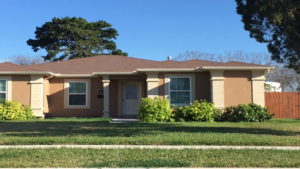It’s something that leaders in the public and private sectors acknowledge. There’s an urgent need for more affordable housing in the Corpus Christi area.
Richard Throop, president and CEO of the Corpus Christi Association of Realtors, says to understand this demand, people need to understand how affordable housing is defined.
“Affordable housing is not Section 8. It’s not government-subsidized housing. It’s just housing that is affordable, similar to healthcare that is affordable,” Throop explains. “So here in Corpus Christi, the average household income is around $52,000. So if you take three times that income, that would mean you would have an affordable home which is about $150,000.”

But according to CCAR, the average home price is now hovering around $200,000. That’s up more $56,000 in the last decade. Unfortunately, those prices have increased at a rate around three times higher than the median household income during the same time span.
Throop says the proof of lack of affordable housing is in the inventory.
“Today in Corpus Christi, we only have 81 homes out of our 1,400 for sale that are under $150,000. That’s with at least 3 bedrooms,” Throop says.
The city’s Housing and Community Development department works year-round to assist potential home buyers with low and moderate incomes. Director Rudy Bentancourt says the current market makes it tough for his staff to meet that demand.
“Anyone building a house more than $150,000 is just not going to qualify for our programs and that’s not affordable for the folks that meet those income guidelines,” Bentancourt explains.

However, he says his office has programs that are trying to spark construction and build up the inventory of affordable housing, both now and in the future. One recently approved by HUD offers home buyers up to $20,000 in down payment assistance for new construction.
Bentancourt adds, “For example, a house is $150,000. They qualify for these programs with those income guidelines; then that knocks off $20,000. So now, the home is $130,000. That meets our client that walks in the door for a brand new home.”
Another program helps out with development costs. It allows lots owned by the city to be transferred to non-profits or interested builders for the construction of an affordable home. Bentancourt says this knocks down the price because the builder isn’t paying for the value of the lot, as part of the city’s agreement. Under those contracts, the interested builders or other groups must build affordable homes on the property within two years. If they don’t, the lots are transferred back to city ownership.
As Bentancourt describes, “It’s a partnership. It’s a win-win partnership that we’re looking to continue as we move forward to addressing affordable housing.”
He says the city’s partners also need to include those on the business side of home building. CCAR agrees, especially when it comes to making sure that families get a fair shot at ownership.
“One of the problems we have is that any time an affordable house in somewhat of a livable condition becomes available on the market, the investors buy it for cash and then rent it out to the people that don’t have the opportunity to buy those homes,” CCAR board chairman Bryan Johnson explains. “So if we’re able to protect the inventory for the first-time home buyers and the families that need it, I think that would give us a good start.”

Johnson hopes that the teamwork will also lead to creative new ideas to boost affordable housing over the next ten to twenty years.
“We need to look to the future. we need to open our arms and hearts and be open to something new because what we’ve been doing down here for the last 15 years just is not working,” Johnson says.
Throop believes that the future of affordable housing in our region boils down to one key factor.
“The first thing we need to do as a community is we need to make housing the number one priority,” he emphasizes.
“We always talk about economic development which is great. We were number one in job creation a couple of years ago here in the Coastal Bend. But when we bring more people into our area for these jobs, they simply don’t have anywhere to live.”
Throop says expanding the affordable inventory for renters should also be a future priority. That’s because more than half of local residents don’t own homes, which makes this area what’s called a “rental only market.” Currently, average rental prices are also higher than a lot of other cities in Texas, including San Antonio.

